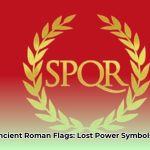Did the ancient Roman Empire truly possess an ancient Roman Empire flag as we envision national flags today? The concept of a singular, universally recognized national flag is a relatively modern invention, emerging centuries after Rome’s zenith. For the Romans, identity, authority, and power were communicated through a rich and evolving tapestry of symbols, standards, and emblems. These visual cues were far more than mere decorations; they were potent embodiments of Roman strength, military prowess, and civic identity, deeply woven into the fabric of their daily rituals and military life. This exploration delves into the iconic symbols that served as the true “flags” of ancient Rome, their profound meanings, and their enduring legacy, including their influence on later imperial entities like the Holy Roman Empire. For further information, check out these Roman symbols.
The Iconic Symbols of Roman Supremacy and Unity
Instead of a single rectangular cloth representing the entire empire, ancient Rome utilized several key symbols carried into battle and displayed in public spaces. Each held profound significance, acting as mobile, visible representations of the Roman state and its ideals.
SPQR: The Enduring Soul of Roman Governance
“Senatus Populusque Romanus”—”The Senate and People of Rome”—is arguably the most recognizable Roman abbreviation: SPQR. Far from a simple inscription, SPQR embodied the very essence of Roman governance and the shared authority between its esteemed Senate and its diverse citizenry. This powerful acronym appeared ubiquitously on public buildings, monuments, and coins, and critically, it was emblazoned on military standards.
The phrase first emerged in inscriptions around 80 BC, a period of significant political tension, serving as a unifying message amidst internal struggles. Its prominence underscored that both the Senate and the Roman populace were fundamental to Rome’s success and legitimate rule, a crucial distinction from traditional monarchical systems. Even as the Republic transitioned into the Empire, SPQR retained its resonance, signifying a power ideally derived from the consent of the people, exercised through their emperor. For Roman legionaries, losing a standard emblazoned with SPQR was considered a profound disgrace, highlighting its deep symbolic weight. Today, SPQR continues as a living part of Rome’s identity, used by the city government and found on manhole covers and public amenities, connecting the modern capital to its incredibly rich past.
The Aquila: Rome’s Unrivaled Military Might
The aquila, or eagle, stood as the paramount emblem of the Roman legions, signifying unrivaled military strength and imperial ambition. Each Roman legion proudly carried its own golden eagle standard, a sacred object representing Jupiter, the king of the gods, and embodying the legion’s very spirit. The presence of the aquila on the battlefield was believed to inspire immense courage in Roman soldiers and strike fear into their enemies.
The reverence for the aquila was immense. Legionaries swore sacred oaths to protect it, often to the death, and its loss in battle was considered the gravest dishonor a unit could suffer. The destruction of three aquilae in the disastrous Battle of the Teutoburg Forest in 9 AD led to decades of dedicated recovery missions, demonstrating their immense national and spiritual importance. This powerful symbol of leadership and martial prowess continues to influence national emblems and heraldry across the globe, centuries after Rome’s peak.
The Vexillum: A Close Kin to a Modern Flag
While not a flag in the contemporary sense, the vexillum comes closest to what we might imagine. It comprised a piece of cloth, typically square or rectangular, suspended from a horizontal crossbar atop a staff. These banners served as rallying points for legions and their smaller subunits, such as cohorts or centuries, displaying the unit’s name, number, or distinct emblem.
The vexillum was essential for battlefield coordination, providing a clear visual marker for soldiers to regroup and maintain formation amidst the chaos of combat. Its design and colors might have carried additional symbolic meanings, though specific details are a subject of ongoing historical research. The word “vexillology”—the study of flags—itself derives from the Latin vexillum, highlighting its historical significance in the evolution of flag design. Commanders would also ride behind their vexilla to announce their presence and inspire troops.
Other Roman Standards and Emblems of Authority
Beyond the aquila and vexillum, Roman military units and political figures employed a variety of other standards (signa) and symbols:
- The Imago: During the Imperial period, a standard bearing the bust or portrait of the reigning emperor, known as the imago, became common. This standard symbolized the emperor’s direct presence and authority over the legions, reinforcing loyalty to the living embodiment of the empire.
- The Draco: Introduced later, particularly after contact with eastern peoples like the Dacians, the draco (dragon standard) was a windsock-like standard resembling a dragon, often with a metallic head and a fabric body that would inflate with the wind, creating a fearsome, whistling sound. These standards were primarily used by cavalry units.
- The Manus: Early Roman military standards sometimes featured a manus, an open hand perched atop a pole, symbolizing the loyalty and trust (fides) of the soldiers.
- The Sigma: Later Roman legions also adopted standards in the shape of the Greek letter sigma, often adorned with medallions or portraits, reflecting the Hellenistic influence on Roman imperial culture.
Beyond Rome: Symbols of the Holy Roman Empire
The legacy of Rome, particularly its imperial aspirations and the concept of universal dominion, persisted long after its classical fall. The Holy Roman Empire, a complex and sprawling entity that dominated Central Europe for a millennium (962–1806), drew heavily on Roman tradition to assert its own authority and legitimacy. This lineage, however, manifested in distinct visual identities, evolving its own unique set of imperial symbols.
The Holy Roman Empire, much like its Roman predecessor, did not possess a single, universally adopted “national flag” in the modern sense. Instead, its identity was represented through various banners, especially the Imperial Eagle, and a consistent use of specific colors.
The Imperial Eagle: A Transformed Symbol
The Imperial Eagle of the Holy Roman Empire was a potent symbol, evolving from a single-headed eagle to a more complex form. Initially, it appeared as a single-headed black eagle, representing the Emperor’s singular rule. However, from the early 15th century, particularly under Emperor Sigismund (r. 1410–1437), it notably transformed into a double-headed eagle. This transformation was highly symbolic, signifying the Emperor’s dominion over both temporal (earthly) and spiritual matters—a unique aspect of the Holy Roman Emperor’s role as a protector of Christendom. This dual-headed emblem also subtly echoed the imagery of the Byzantine Empire, a powerful rival claiming succession to Roman heritage, reinforcing the HRE’s claim as the true successor to Rome. Early depictions, according to Meyers Konversations-Lexikon of 1897, included Archangel Michael banners (Henry the Fowler) and an eagle over a dragon (Otto IV), before the consistent Imperial Eagle design emerged.
Black and Gold: The Imperial Palette
The dominant Holy Roman Empire flag colors were almost universally black and gold. These colors were strategically chosen to project an image of immense strength, wealth, and prestige. The Emperor’s main banner typically featured a black eagle, often with striking red talons and beak from the late 13th or early 14th century, set against a shimmering golden backdrop. This bold color scheme conveyed a clear message of imperial authority and unwavering power. After the Holy Roman Empire’s dissolution in 1806, these colors were notably adopted by the Austrian Empire under Francis I, maintaining a visual link to the imperial lineage that persisted until 1918.
Red and White: Crusader, Hanseatic, and Factional Colors
Beyond the imperial black and gold, the colors red and white also held significant symbolic weight within the Holy Roman Empire. During the Crusades, the Empire’s war flag, known as the “Saint George Flag,” was a white cross on a red background. This design was the reverse of the St. George’s Cross used by Lombardy and England and flew alongside the black-gold imperial banner.
Red and white were also the prominent colors of the Hanseatic League (13th–17th centuries), a powerful medieval commercial and defensive confederation of merchant guilds and market towns in Northern Europe. Hanseatic trading ships were identifiable by their distinctive red-white pennants, and most Hanseatic cities adopted red and white as their city colors, a legacy still visible in cities like Hamburg and Bremen.
Furthermore, in northern Italy, during the tumultuous conflict between the Guelphs (pro-Papacy) and Ghibellines (pro-Empire) from the 12th to 14th centuries, the Ghibelline communes adopted the Holy Roman Emperor’s war banner (white cross on red) as their own. Guelph communes reversed these colors, displaying a red cross on white. These heraldic schemes remain prevalent in the civic heraldry of northern Italian towns today, serving as a revealing indicator of their past factional allegiances.
Specific Imperial Banners: Reichsfahne and Reichssturmfahne
The Reichsfahne (Imperial flag) was an early field ensign, serving as a war flag for the united armed forces of the Empire until the late 15th century. It frequently displayed a white cross on a red field in the 12th century, evolving later to incorporate the Imperial eagle. This banner was sometimes granted by the King to local lords to authorize their enforcement of peace, as when King Sigismund gave it to the Swiss Confederacy in 1415, sanctioning their war against the Habsburgs.
The Reichssturmfahne (“Imperial War Flag”) emerged in the late medieval period, distinct from the Reichsfahne. It was treated as an Imperial fief, traditionally granted to Swabian nobles and notably to Ulrich III, Count of Württemberg, in 1336. This flag showed the Imperial eagle in a square field, often with a red Schwenkel (pennon) atop it. It remained part of the heraldic insignia of the House of Württemberg until the 19th century, with the actual flag kept in Stuttgart until its destruction in a 1944 bombing raid. This flag is not to be confused with the Reichsrennfahne, which depicted two crossed swords in a black and white field, granted to the Electors of Saxony in their role as Reichserzmarschall.
Enduring Legacy and Transformation of Roman Symbols
The visual language of Rome was dynamic, adapting over centuries to reflect its expansion, cultural assimilation, and religious shifts. Understanding this evolution of Roman symbols offers profound insights into their values, power structures, and cultural identity.
From Paganism to Christianity: A Symbolic Shift
The rise of Christianity within the Roman Empire instigated a significant transformation in its symbolic landscape. Pagan symbols were either reinterpreted through a Christian lens or entirely replaced. The Chi Rho, formed from the first two Greek letters of “Christ” (XP), gained immense popularity after Emperor Constantine the Great adopted it as a military standard, famously placing it on his soldiers’ shields before the Battle of Milvian Bridge in 312 AD. This profound religious shift dramatically reshaped Roman visual culture and public display, paving the way for Christian iconography to become dominant.
Laurel Wreaths: From Triumph to Academia
The laurel wreaths, rooted in their association with the god Apollo and victory, symbolized honor and triumph. Roman emperors, victorious generals, and celebrated athletes were crowned with laurel wreaths to signify their achievements. Intriguingly, this ancient symbol transcended its pagan origins, finding its way into Christian symbology to represent Christ’s triumph over death. Today, the laurel wreath remains a powerful emblem, prominently featured in academic ceremonies to denote scholarly achievement and excellence, a direct lineage from its Roman imperial use.
The Fasces: A Double-Edged Symbol of Authority
The fasces—a bundle of wooden rods bound together, often with an axe protruding from the center—was a powerful symbol of state authority and unity. Lictors, official attendants, carried these bundles before Roman magistrates, visually asserting the magistrate’s power to punish (rods for scourging, axe for capital punishment). While representing magisterial authority and collective strength in ancient Rome, the adoption of fasces by 20th-century political movements, specifically fascism, regrettably tainted its historical meaning, demonstrating how symbols can be co-opted and their original connotations distorted.
The She-Wolf: Rome’s Mythic Origins
The Capitoline Wolf, depicting a she-wolf nursing the legendary founders of Rome, Romulus and Remus, is an iconic symbol of Rome’s mythic origins and its enduring legacy. This imagery speaks to the deep-seated cultural narratives that Romans used to define their identity and their exceptional destiny, emphasizing their divine favor and resilience.
Roman Symbols: A Cultural Melting Pot
Rome was not an isolated cultural entity. As its empire expanded, it remarkably integrated symbols and motifs from conquered lands. Greek deities, Egyptian designs, Celtic patterns – diverse cultural elements all found a place within the evolving Roman symbolic lexicon. This strategic cultural synthesis not only enriched Roman artistry but also strengthened the empire by incorporating and acknowledging the identities of its vast territories.
The study of these symbols, from the ubiquitous SPQR to the awe-inspiring Aquila and the multifaceted emblems of the Holy Roman Empire, offers a rich understanding of ancient Roman and medieval European culture, military organization, and the enduring power of visual communication. These emblems, whether the ancient Roman Empire flag as we sometimes mistakenly conceive it or the more nuanced Roman standards and imperial banners, continue to enthrall us, providing a glimpse into the grandeur and complexity of civilizations that profoundly shaped the Western world.
References:
- Flags of the Holy Roman Empire – Wikipedia
- SPQR – Wikipedia
- Did the Roman Empire Have a Flag? Exploring Roman Symbols and Standards – romanempirehistory.com
- How did the ancient Roman flag look? – ancient-rome.info










